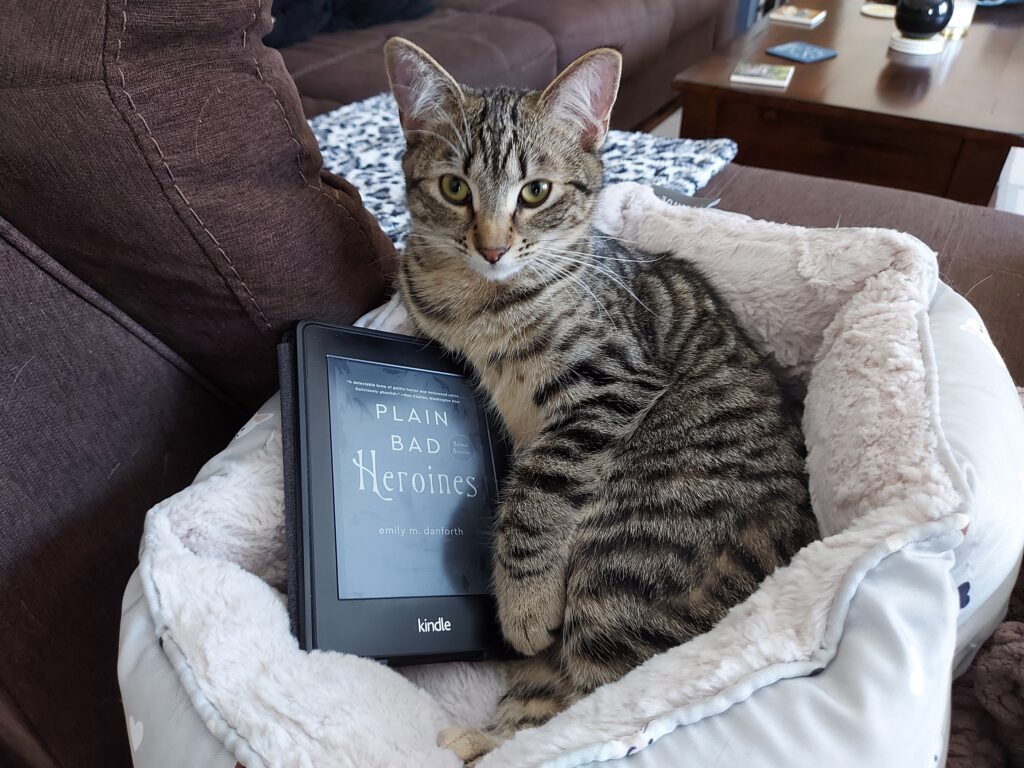Plain Bad Heroines by emily m. danforth

Plain Bad Heroines by emily m. danforth is a mishmash of different genres: we’ve got supernatural horror, historical fiction, queer romance and a modern riff on fame and the movie industry. Plain Bad Heroines is also meta-fiction as it is about a book that sets off a chain of events in the past that are written about in a book in the present that is being turned into a movie. I can see why people would be drawn to this novel, because it does sound interesting on the face of it, but I would have liked it better if I had not been so annoyed by the narrative voice employed by the author and if it did not have such an abrupt ending.
The book at the center of Plain Bad Heroines is the real-life autobiographical The Story of Mary MacLane which was published in 1901. In this book, Mary MacLane rejects the conventional societal roles for women at the time and says that she wants to be “bad”. She also writes about her sexual feelings for the Devil and other women. The book was quite the sensation at the time it was released, and not necessarily in a good way, although it did inspire young women to follow Mary MacLane’s lead, like the young ladies who attend the fictional Brookhants School for Girls in Plain Bad Heroines. In 1902, two Brookhants students, Clara and Flo, who were said to be in love with each other, form The Plain Bad Heroine Society to celebrate their love for The Story of Mary MacLane. However, they are soon found dead in the orchard next to the school, with Mary MacLane’s book, stung to death by a swarm of yellowjackets. The book goes missing, until it is found next to the body of another student, and then Brookhants School starts to develop a reputation for being cursed. Libbie Brookhants, the owner of the school and its principal, feels bad for what happened to Clara and Flo because she was the one who gave them The Story of Mary MacLane, but she keeps this from her partner, Alexandra (Alex). Parents start pulling their daughters out of the school and it looks like it may have to close. At the same time Alex appears to be having a manic breakdown, or is she being affected by the curse? Is the curse even real?
The historical storyline in Plain Bad Heroines is interweaved with the present-day storyline where Merritt Emmons has written a hit book about Clara and Flo called The Happenings at Brookhants. Her book is being turned into a movie starring and produced by Hollywood’s latest It Girl, Harper Harper (a pretentious name if I ever did hear one), who will be playing Flo, and with Clara to be played former child star, Audrey Wells, whose mother is a former Scream Queen from the 1980s. Audrey, Harper and Merritt each identify as queer, and they start developing feelings for each other as they work together on the movie, which is being filmed on location at the derelict Brookhants School. Of course, strange things start happening on set which are being attributed to the Brookhants curse.
I found the historical storyline featuring Libbie and Alex to be more interesting as it explains the origins of the “curse” and tells a complete narrative; their relationship is also the more compelling relationship. The present-day storyline really takes its time even getting to the film set at Brookhants School and focuses mostly on the developing relationship between Audrey, Harper and Merritt. With Plain Bad Heroines, danforth is giving queer characters and stories, which have historically been erased, a voice. She skewers the idea that queerness is the root of immorality. But she is also supposed to be telling a supernatural horror story, and that is where Plain Bad Heroines loses its cohesiveness. One would think the purpose of weaving the historical timeline with the present timeline would be to link the two timelines together, but that does not completely happen here. Odd and creepy things happen on the movie set that give credence to the “curse” at Brookhants, but Audrey, Harper and Merritt do not really investigate the curse and then their story just ends.
If you decide to read this book, I do not recommend reading it in an e-format. I read Plain Bad Heroines on my Kindle, and it turns out there were footnotes scattered throughout the book that played into the whole tongue-in-cheek, mocking narrative voice. On the Kindle, the footnotes showed up at the very end of the book, so I have no idea where they tied into the story. And speaking of the narrative voice, I have already mentioned how annoying it is. This is because the narrator keeps addressing the reader directly (i.e. “Dear Reader”). I wish danforth had left this literary device in the past where it belongs. Her humour, on the other hand, I appreciated. I think this novel has really great potential, it is just too bad that it was bogged down by a slow pace and that present-day storyline was not utilized to resolve the historical storyline.